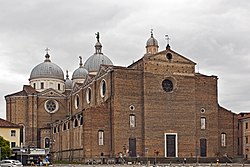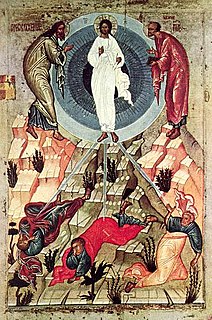
Bernard of Clairvaux, O. Cist., venerated as Saint Bernard, was an abbot, mystic, co-founder of the Knights Templars, and a major leader in the reformation of the Benedictine Order through the nascent Cistercian Order.

Mark the Evangelist, also known as Saint Mark, is the person who is traditionally ascribed to be the author of the Gospel of Mark. According to Church tradition, Mark founded the episcopal see of Alexandria, which was one of the five most important sees of early Christianity. His feast day is celebrated on April 25, and his symbol is the winged lion.

Padua is a city and comune in Veneto, northern Italy. Padua is on the river Bacchiglione, west of Venice. It is the capital of the province of Padua. It is also the economic and communications hub of the area. Padua's population is 214,000. The city is sometimes included, with Venice and Treviso, in the Padua-Treviso-Venice Metropolitan Area (PATREVE) which has a population of around 2,600,000.
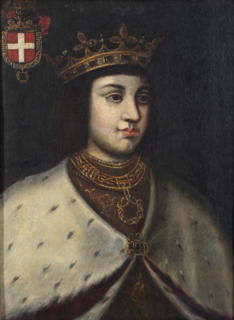
Amadeus IX, nicknamed the Happy, was the Duke of Savoy from 1465 to 1472. The Catholic Church venerates him with a liturgical feast on March 30.
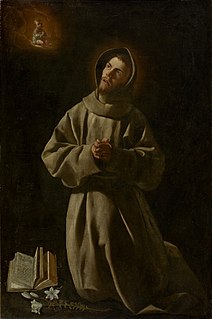
Anthony of Padua or Anthony of Lisbon was a Portuguese Catholic priest and friar of the Franciscan Order. He was born and raised by a wealthy family in Lisbon, Portugal, and died in Padua, Italy. Noted by his contemporaries for his powerful preaching, expert knowledge of scripture, and undying love and devotion to the poor and the sick, he was one of the most quickly canonized saints in church history, being canonized less than a year after his death. He was proclaimed a Doctor of the Church by Pope Pius XII on 16 January 1946.
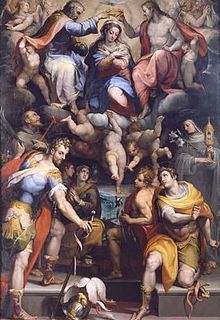
Nabor and Felix were Christian martyrs thought to have been killed during the Great Persecution under the Roman emperor Diocletian. A tomb in Milan is believed to contain their relics.

Willibald was an 8th-century bishop of Eichstätt in Bavaria.

Justina of Padua is a Christian saint and a patroness of Padua. Her feast day is October 7. She is often confused with Justina of Antioch. She was devoted to religion from her earliest years and took the vow of perpetual virginity. When she was brought before Maximian the prefect, she remained firm against all attacks. The prefect caused her to be slain with the sword.
Elias of Jerusalem was a bishop and Patriarch of Jerusalem from 494 until he was deposed by Byzantine Emperor Anastasius I in 516 for supporting the decrees of the Council of Chalcedon. Elias was an Arab, by birth, who had been educated in a monastery in Egypt. At the Synod of Sidon (512) he successfully defended, together with Flavian II of Antioch, the dyophysite Christological doctrine proclaimed by the Council of Chalcedon.

Joseph Marchand was a French missionary in Vietnam and a member of the Paris Foreign Missions Society. He is now a Catholic saint, celebrated on 30 November.
Saint Philetus is, along with Saints Lydia, Macedo(n), Theoprepius (Theoprepides), Amphilochius and Cronidas (Cronides), venerated as a Christian martyr. Philetus was supposedly "...a senator who resided in the province of Illyria and was put to death during the persecution under Emperor Hadrian]..."
Rictrude was abbess of Marchiennes Abbey, in Flanders. The main early source for her life is the Vita Rictrudis, commissioned by the abbey, and written in 907 by Hucbald.
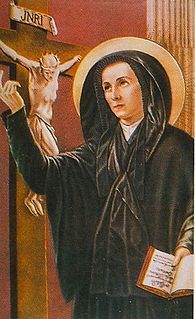
Lucy Filippini is venerated as a Catholic saint. She founded the Institute of the Maestre Pie, dedicated to the education of young girls.
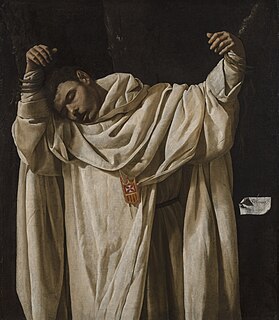
Saint Serapion or The Martyrdom of Saint Serapion is a 1628 oil on canvas painting by the Spanish artist Francisco Zurbarán (1598–1664). The work was commissioned by the Mercedarian Order to hang in the De Profundis hall of their monastery in Seville. Zurbarán is noted for his portrayals of penitent or martyred monks and saints. Critic Tom Lubbock used this painting to illustrate a difference in the way the martyrdom of two different saints were depicted. He contrasted the understated and calm depiction of St. Serapion's violent death, with the equally or more violent death of the Jesuit priest and martyr Saint Edmund Campion (1540–1581) who was publicly hanged, drawn and quartered in London in December 1581. The art critic draws a comparison in the manner of depiction of Campion's death and that of Saint Serapion of Algiers (1179–1240), a Mercedarian friar who fought in the Third Crusade of 1196 and was later martyred.

Saint Annemund, also known as Annemundus, Aunemundus, Ennemond and Chamond, was an archbishop of the Archdiocese of Lyon. Annemund was a councillor of Clovis II and a friend of Wilfrid of York. The year of his death is variously given as either 657 or 658. He is venerated as a saint in the Catholic Church.
Saint Sixtus of Reims is considered the first bishop of Reims. According to Hincmar, a 9th-century archbishop of Reims, Sixtus was sent from Rome by Pope Sixtus II to Gaul to assist in Christianizing the region. Another tradition makes him, anachronistically, the disciple of Saint Peter. According to tradition, Sixtus of Reims, along with his companion St. Sinicius (Sinice), established the Christian sees of Reims and Soissons. Sinicius would later succeed Sixtus as bishop of Reims. According to one source, “it would appear that Sixtus did not die as a martyr, despite the severity of the persecution during the era.”
Warinus of Poitiers was the Franco-Burgundian Count of Poitiers and Count of Paris. He was from an established noble family. He opposed Ebroin's efforts to expand Neustrian power and was killed at Arras in 677.
Matthew Bunson is an American author of more than fifty books, a historian, professor, editor, Roman Catholic theologian, Senior Contributor for EWTN, the Catholic multimedia network, Senior Fellow at the St. Paul Center for Biblical Theology, and Faculty Chair at Catholic Distance University.
Felix (d. 303) was a bishop of Thibiuca in Africa who was martyred during the Great Persecution under the Roman emperor Diocletian alongside Audactus, Fortunatus, Januarius, and Septimus. Felix is said to have resisted the command of the local magistrate Magnillian to surrender his church's copies of the Christian scriptures. In one account, Felix and the others were taken to Carthage and decapitated on July 15. These Five Martyrs of Carthage were venerated in the basilica of St Faustus. Another placed his martyrdom at Venosa in Italy. His companions may have been deacons but, apart from their joint martyrdom with Felix, are now unknown. Their feast day was observed jointly on October 24.
George Douglas was one of the Eighty-five martyrs of England and Wales.
